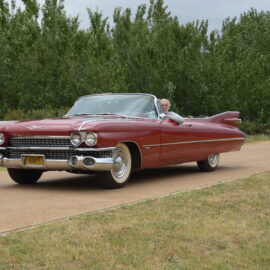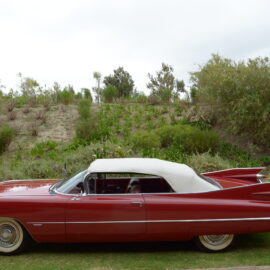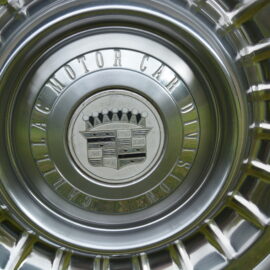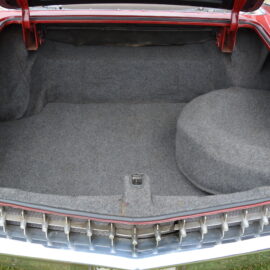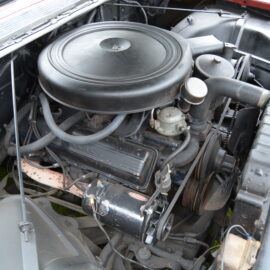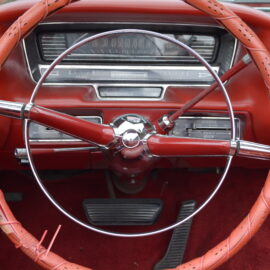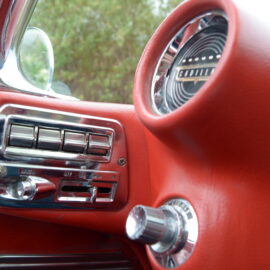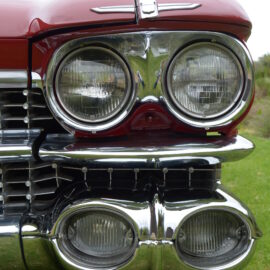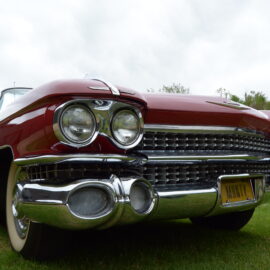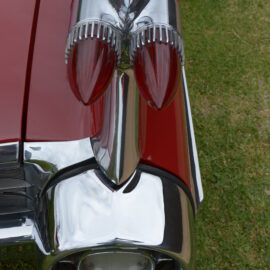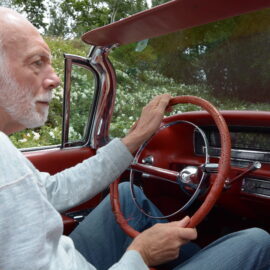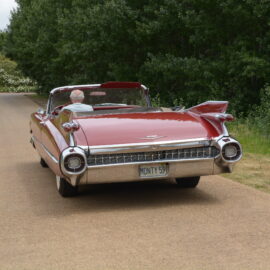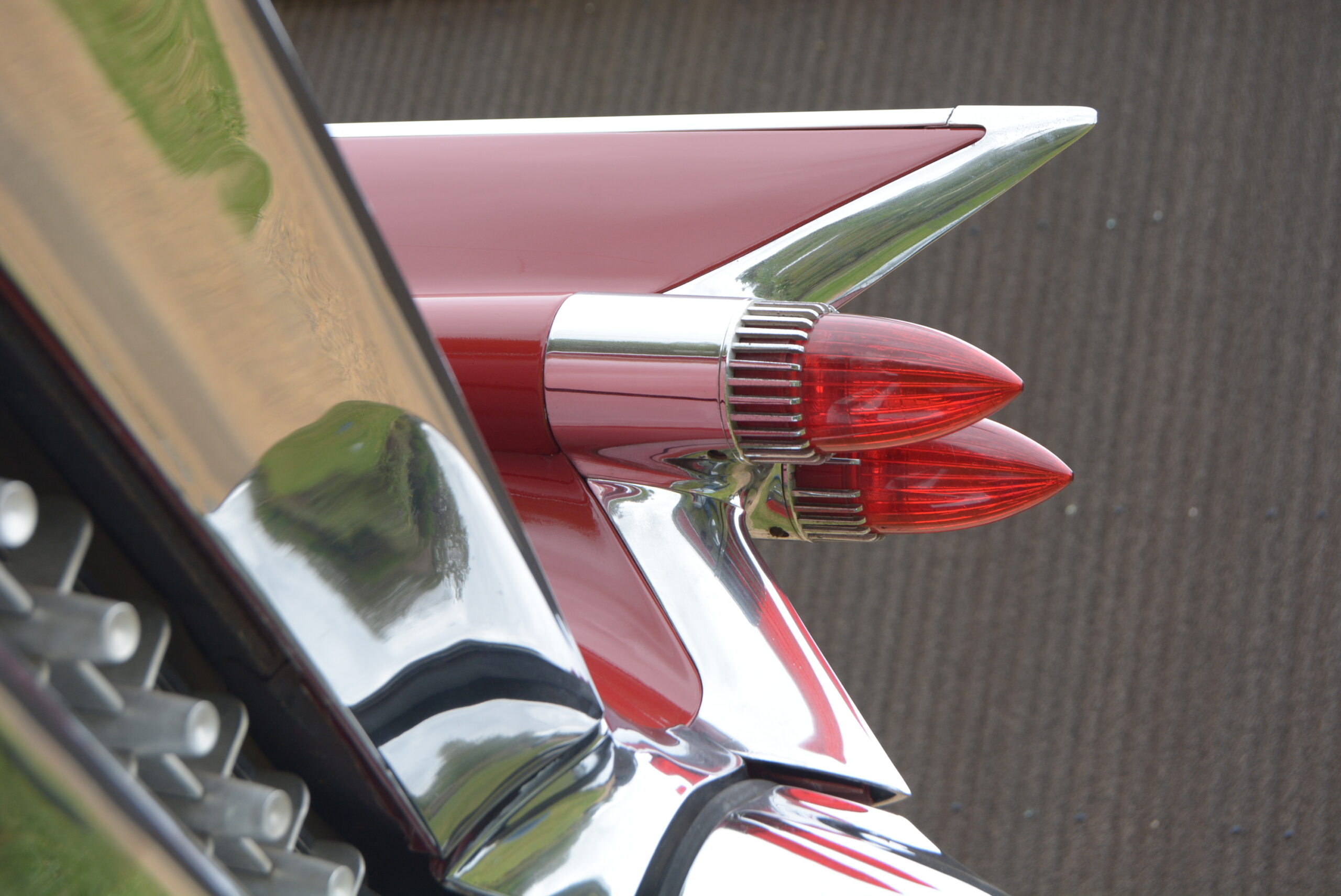
12 Dec Collection in action: Cadillac Eldorado Biarritz Convertible
Summer’s here and time to let the hood down in a fin-tastic example of American automotive excess. Mike Monk goes cruisin’ in Cadillac’s outrageous Series 62 convertible…
Some cars are destined to become symbolic of a particular period in automotive history. The late-1950s was a time of American design and detail extravagance, when bodies were manufactured from sheet metal by the hectare highlighted with space-age styling influences and adorned with glitter. Like most fashion crazes, the bubble had to burst and it happened at the turn of the decade – but not before what is . Just saying the name conjures up images of cruising along the Pacific Coast Highway under a clear blue sky and blazing sunshine with the top down and Buddy Holly singing Peggy Sue on the radio, epitomizing the good life.
But the car’s introduction was in the wake of a sharp worldwide economic downturn in 1958 when sales in the American automotive market fell by 37% over the previous year, the industry’s worst post-war return. Unemployment in Detroit reached 20% in April as imports continued to be high, but the manufacturers remained positive in anticipation of a turnaround in fortune and continued to work on new model lines. At Cadillac, this meant developing the sixth generation of the Series 62, a multi-faceted model line that began in 1940 with subsequent generations appearing in 1942, 1948, 1954 and 1957. In a generally affluent post-war America, model lives were short as manufacturers sought to keep showroom traffic at a maximum.
The 1959 Cadillacs were all-new designs with steel bodies mounted on a cross-frame chassis and comprised three sub-series coded 6200 (base models), 6300 (DeVille) and 6400/6900 (Eldorado and Brougham) centred on five base models all with similar wheelbases and lengths, collectively a range of 14 derivatives. It is the latter that we are interested in here, the 6400 relating to Eldorado SeVille and Biarritz models and 6900 to the more bespoke, limited production Brougham. Yes, it is a little confusing…
The Series 6400 specification sheet had plenty of boxes ticked – an oil filter, power drum brakes, power steering, foglamps, dual reverse lights, windscreen washers and two-speed wipers, exterior rear-view mirror and a heater were all standard. Exterior-wise, the Biarritz carried rear wheel spats while interior features included power door locks, power windows and quarter-lights, a six-way power front seat, a remote boot lock, a radio with rear speaker, courtesy and map lights, an electric clock – and four cigarette lighters. Upholstery was single or two-tone leather. Amongst a long list of options were front bucket seats (no extra cost), tinted glass, air conditioning, cruise control and Autronic Eye automatic headlight dimming – high-tech for 55 years ago.
Powering this palace on wheels, a 390ci (6 390 cm3) V8 with hydraulic lifters and three dual-barrel Rochester carbs was utilised, pumping out 257 kW and a massive 589 N.m of torque. Drive to the rear wheels was courtesy of a three-speed HydraMatic autobox. Performance figures of the time realised a top speed of 185 km/h, a 0-96 km/h time of 10,3 seconds and an average fuel consumption figure of 23,2 ℓ/100km.
To complement the effortless performance, the 5 715 mm long, 2 060 mm wide, near-2 400 kg Biarritz Convertible offered the boulevard ride most post-war American cars were renowned for, helped, in this instance, by air suspension. With a 3 302 mm wheelbase and riding on 8.20×15 tyres, the car literally floats along, its bulk compensated for by all the power-assisted driver aids.
Although all the body panels were made up of sheet metal the size of an average town house garden, most carrying chromed ornamentation of one kind or another, it is those amazing tail fins that dominate what is an imposing example of automotive architecture. The tip of the fin, nicknamed ‘zap’, has been quoted as being 42 and 46 inches from the ground (1 067-1 168 mm) – the average height of a six-year child – but on the featured car here it measured 45 inches (1 143 mm), the variations perhaps as a result of the air suspension’s condition? Certainly, they were never topped and those on the seventh generation Series 62 were slightly lower and less ornate. Indicative of the space-age ’50s, the zaps on the sixth generation models were flanked with rocket-ship tail-light nacelles housing conical lenses. Some cars had chromed nacelles but more commonly they were body colour: either way, they formed part of a glittering structure oozing glitz and glamour out of this world.
Murphy’s Law dictated that on the appointed photoshoot day grey clouds and the threat of showers put paid to any California Dreamin’ imagery. But it was still warm enough to release two header-rail latches and electrically lower the fabric hood for some al fresco motoring in the FMM’s Seminole Red 1959 Eldorado Biarritz. First impressions are, naturally, of the car’s massive physical presence and the prospect of guiding it through some regular-sized gateways onto the open road is a little daunting. However, once settled on the three-abreast front seat looking out over the dining table-sized bonnet, tiny fender-top fins acted as useful markers of the extremities.
The big, lazy V8 fires up with no fuss, select Drive via the column-shifter and pull away with luxury-liner celebration. Ridiculously light steering takes a little while to appreciate until some tight manoeuvring is required and the car’s amazingly small turning circle is revealed, with only the rear overhang needing consideration. With pretty much ‘power everything’, the zap-mobile is an absolute doddle to drive. Get-up-and-go is a toe-squeeze away, the transmission hardly being put to task but when called into action, changes gear with that period American autobox slur.
Some bonnet flutter belies just how smooth and level the car rides, the wraparound windscreen doing a good job of deflecting the airstream. Sure, handling is of the seafaring variety but the brakes are effective and once accustomed to the feather-like steering, progress is majestic and serene, the grin factor huge as the world around passes by in the wake of what turns out to be one of the motoring world’s most alluring and friendliest leviathans.
Incidentally, the Eldorado nameplate is a contraction of two Spanish words that translate as ‘the gilded (ie golden) one’ and also refers to El Dorado, the mythical South American ‘Lost City of Gold’ that fascinated Spanish explorers. The name was adopted by Cadillac after an in-house competition to name a 1952 concept vehicle celebrating the company’s golden anniversary. It was proposed by a secretary in Cadillac’s merchandising department, Mary-Ann Marini, and was first used in 1953 on a limited-edition convertible. Beginning in 1956, Cadillac named the Eldorado convertible after the French coastal resort of Biarritz.
Just 1 320 Series 6400 convertibles were built in 1959 (together with 975 SeVilles and 99 Broughams) with a sticker price of $7 401, the price of a sizeable American home. Variously described as being outrageous, ebullient and flamboyant, critics called the 1959 Cadillacs over-long, over-low and over-styled – “the final flourish of the Fifties” – but today the Eldorado Biarritz Convertible stands as the pinnacle of post-war American auto design extravagance. And hey, if you’ve got it, why not flaunt it? You certainly will not go unnoticed…
(While certain lockdown restrictions still apply on movement and accessibility, this story is based on my article that first appeared in the Dec/Jan 2014/5 issue of Classic & Performance Car Africa magazine – MM.)




